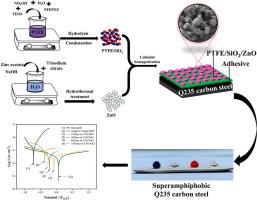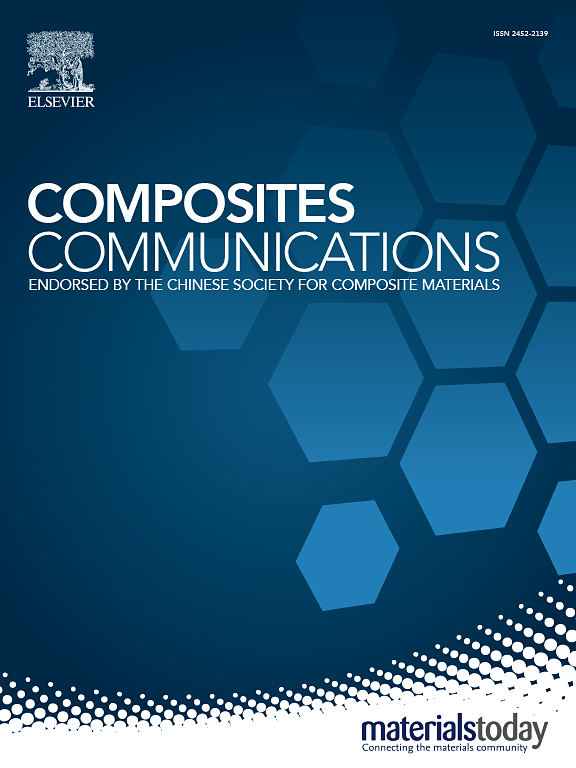通过超憎水性复合涂层对 Q235 碳钢进行表面工程处理,实现强大的耐腐蚀性和防污性
IF 6.5
2区 材料科学
Q1 MATERIALS SCIENCE, COMPOSITES
引用次数: 0
摘要
开发一种有效的策略来确保 Q235 碳钢免受液基污染物的腐蚀是一项具有挑战性的工作。虽然超疏水和超疏水涂层已经制造出来,但它们对油性液体的易感性和较差的机械坚固性仍然限制了它们解决腐蚀问题的能力。本文通过胶体均化途径,将氧化硅的增强特性和氧化锌的机械及热稳定性结合到聚四氟乙烯聚合物基体中,合成并制备了一种新型坚固的超疏水性纳米复合材料。新开发的复合材料呈现出分层凹凸结构,具有优异的防水防油性能。重要的是,这种复合材料在 100 克载荷下可承受 2000 厘米距离的砂纸磨损,具有很强的机械稳定性,而且与基材的附着力更强。因此,涂有这种复合材料的 Q235 在盐水中具有长达 120 天的优异耐腐蚀性,在大多数腐蚀性介质中具有良好的自清洁和防污能力。这一发现揭示了抵抗 Q235 碳钢腐蚀的新途径,从而使这一策略在工业和海洋环境中得到实际应用。本文章由计算机程序翻译,如有差异,请以英文原文为准。

Surface engineering of Q235 carbon steel through a superamphiphobic composite coating enabling robust corrosion resistance and antifouling
Developing an efficient strategy to ensure the resistance of corrosion on Q235 carbon steel from liquid-based contaminants is a challenging work. Although superhydrophobic and superamphiphobic coatings have been fabricated, their susceptibility to oily liquids and poor mechanical robustness still limits their ability to tackle corrosion. Herein, the synthesis and fabrication of a new robust superamphiphobic nanocomposite was presented by combining the reinforcement properties of silicon oxide and the mechanical and thermal stability of zinc oxide into a polytetrafluoroethylene polymer matrix via a colloidal homogenization route. The newly developed composite exhibits a hierarchical bumpy structure, leading to excellent water and oil repellent properties. Importantly, the composite possesses a robust mechanical stability to sandpaper abrasion over a distance of 2000 cm under a 100 g load and a stronger adhesion to substrate. As a result, Q235 coated with this composite exhibits an excellent corrosion resistance in saline water for up to 120 days, and a good self-cleaning and antifouling abilities in most corrosive media. This finding reveals a new pathway for resisting the corrosion attacks on Q235 carbon steel and thereby rendering this strategy with practical application in industrial and marine settings.
求助全文
通过发布文献求助,成功后即可免费获取论文全文。
去求助
来源期刊

Composites Communications
Materials Science-Ceramics and Composites
CiteScore
12.10
自引率
10.00%
发文量
340
审稿时长
36 days
期刊介绍:
Composites Communications (Compos. Commun.) is a peer-reviewed journal publishing short communications and letters on the latest advances in composites science and technology. With a rapid review and publication process, its goal is to disseminate new knowledge promptly within the composites community. The journal welcomes manuscripts presenting creative concepts and new findings in design, state-of-the-art approaches in processing, synthesis, characterization, and mechanics modeling. In addition to traditional fiber-/particulate-reinforced engineering composites, it encourages submissions on composites with exceptional physical, mechanical, and fracture properties, as well as those with unique functions and significant application potential. This includes biomimetic and bio-inspired composites for biomedical applications, functional nano-composites for thermal management and energy applications, and composites designed for extreme service environments.
 求助内容:
求助内容: 应助结果提醒方式:
应助结果提醒方式:


